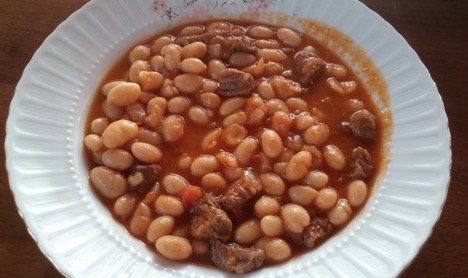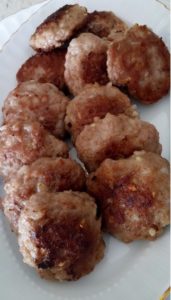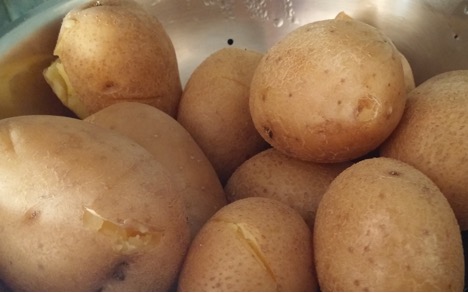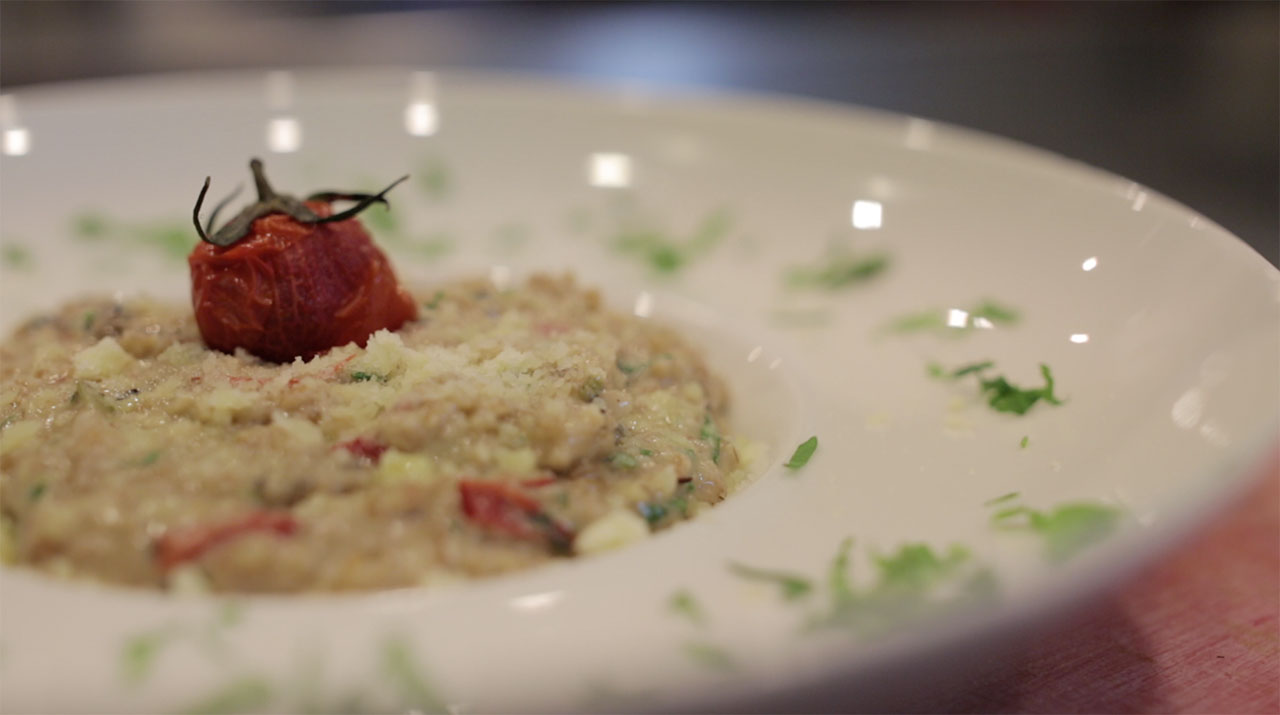When I first moved to Turkey from Ireland I could barely cook. Boiling vegetables was easy, and I could cook a mean mushroom omelette, but that was about it. As I learned to cook from my husband, with much learned in a few weeks spent with my mother-in-law each summer, I became more adventurous than the typical Irish fare of boiled veg (potatoes, carrots, turnips, cabbage) and meat. The rich variety and depth of flavour in each Turkish meal was astounding.
But then I was faced with a challenge; my husband had trouble with his gallbladder and we needed to clear his diet of fat and most meat. The alternative was severe pain after eating as we waited for his operation.
We typically ate a range of home-made Turkish and international dishes; lasagne, sautés of meat, mushrooms, peppers in a rich tomato sauce served with rice fried in butter, köfte fried and sizzling in oil,

Kuru fasulye – meaty and rich and forbidden
potato chips rough cut by hand and shallow fried with a few green Charlston peppers thrown on top to cook in the steam, karnıyarık eggplants fried then stuffed with mince and baked, kuru fasulye dry beans cooked in a meaty sauce. It was rich, tasty and reasonably healthy, or so I convinced myself.
Out for a quick bite we’d choose from a geography of köfte – Tekirdağ, İnegol, Biga or Akçaabat. Black Sea pide was a favourite with a choice of mince fully wrapped by the dough cut just enough to slide a raw egg in after taking it out of the oven, or an open round filled with Black Sea cheese skimmed by a lake of oil. Another alternative was Edirne ciğer, thinly sliced liver dipped in flour and fried.

Köfte – definitely off the menu
Or perhaps we’d head for the et mangal for grilled meat, a difficult choice between lamb, steaks, more köfte, spicy sucuk or Adana kebap and a host more. For a real treat we went for Iskender kebab, döner kebap on a bed of pide covered with tomato sauce and topped with a generous splash of melted butter served at the table by the waiter. Though all were served with salads or soups, they could hardly be viewed as healthy.
Initially we cut down before cutting out and tried to eat more vegetable dishes. Shallow frying was out, as was butter, but oils were cut in half and fat free meat bought. Meat was reduced to a taste. Köfte were grilled, strictly rationed and eventually banned. Dinner became bland and boring. We both resented having to cater for his discomfort, rather than eating normally.
Over time, reductions weren’t enough. Boiled potatoes made an appearance, bringing back my Irish childhood. Boiled potato accompanied every meal then, sometimes mashed and roast on Sundays. Having turned his nose up at them for 14 years unless they were smothered in olive oil, raw onion, green peppers and liberally sprinkled with red pepper and parsley, served plain they

Boiled spuds in their jackets – on the menu every day without fail
became my husband’s staple. Roast chicken remained on the menu though the patient was only given breast meat and no skin under any circumstances. In the end we alternated boiled spuds and roast chicken or turkey, with a chicken soup made with breast, potatoes and carrots and boiled rice.
There were two signs the end was coming. The first was tea. I tried different combinations of tea leaves into boiling water or water onto tea leaves or 12 minutes brewing or 8; it didn’t matter the tea was awful every time. I couldn’t taste much difference, but it seemed like my husband’s taste buds had been subtly affected. I couldn’t win.
The second sign involved breakfast. I had managed to find a replacement for the Turkish breakfast of white cheese, olives (another mysteriously not-up-to-scratch item), jams and helva – porridge. I should have seen it for what it was, a sign my Turkish husband was not well at all. I had eaten it occasionally in the winter and he was unmoved by the charm of a steaming bowl. He positively loved the joke about the English man who sneered at the Scotsman that oats were only used to feed horses in England, not people. The Scotsman replied “Aye, that’s why England is famous for its horses and Scotland is famous for its men!”
None the less my husband was eating porridge every morning, with a drizzle of honey and a few raisins for flavour. I can’t say he ever grew to like it, but it became familiar and safe. Always a good thing when you’re not feeling well.
It was a relief when he finally had the operation and recovered. We could go back to the international mix of Turkish, Italian and whatever I feel like throwing together. And the occasional Iskender kebap drizzled with melted butter…
Still it doesn’t say much for your national cuisine when it’s what constitutes sick food.

Catherine Yiğit is a writer and translator who lives in northwestern Turkey near the mythical city of Troy. Born, bred and buttered in Dublin, Ireland, she arrived in Turkey in 2001 having circumnavigated the globe. You can learn more at her website the Skaian Gates.

Comments ( 0 )